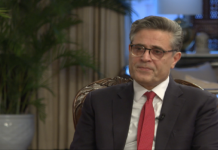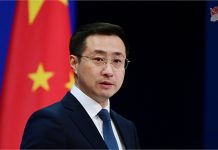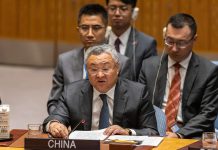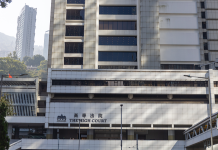
On the sidelines of the General Debate of the 79th Session of the United Nations General Assembly (UNGA), held in New York City from September 24 to 30, an important diplomatic exchange occurred between the U.S. and China. On September 27, member of the Political Bureau of the Communist Party of China Central Committee and Chinese Minister of Foreign Affairs Wang Yi met with U.S. Secretary of State Antony Blinken, at the latter’s request. This marked their fourth meeting of the year, following their previous encounter in Laos two months earlier and a visit to China by U.S. National Security Advisor Jake Sullivan in August.
Unlike their prior meetings, this latest exchange took place on the sidelines of UNGA activities rather than being a specially arranged summit, lending it a different context. In recent years, it has become common for Chinese and U.S. officials to meet on the sidelines of multilateral events such as this.
The Chinese Ministry of Foreign Affairs described the talks as “candid and substantive,” while the U.S. State Department characterized them as “productive,” reflecting the continued complexity and importance of communication between the two global powers.
A respectful dialogue
Unlike previous high-profile announcements, such as when Blinken unilaterally disclosed the Laos meeting one week in advance, the U.S. opted for a more subdued approach this time.
So why the shift? On September 28, Su Xiaohui, Deputy Director of the American Studies Institute at the China Institute of International Studies, explained to Yuyuantantian, a social media account affiliated with China Media Group, that the U.S. typically uses “high-profile warm-ups” to send specific signals. For instance, the July meeting coincided with the Association of Southeast Asian Nations (ASEAN) Regional Forum Foreign Ministers’ Meeting. Aware that ASEAN countries preferred not to take sides between major powers, the U.S. sought to assert its influence in China-U.S. relations through a more public approach.
However, with the U.S. election season entering a pivotal phase, with November 5 being Election Day, the Biden administration faces new pressures in managing China-U.S. relations. They need to balance avoiding conflicts that could impact election outcomes with ensuring they are not perceived as going easy on China, Su pointed out. As a result, a lower-profile strategy seems more prudent at this juncture.
Additionally, according to Su, the U.S. once believed in the power of “microphone diplomacy,” assuming that public displays could give them a psychological advantage. After several engagements, however, it has become clear that real progress requires substantive discussions. While China remains open to dialogue, Beijing has consistently emphasized that communication must address the root causes of any tensions, not just superficial issues.
“The United States should not approach China with two faces: on the one hand, brazenly encircling and suppressing China, while, on the other, engaging in dialogue and cooperation as if nothing is wrong,” Wang remarked candidly during their meeting. His statement reflected a sense of frustration with what China perceives as the U.S.’ inconsistent policy approaches, saying one thing and then doing another.
On September 23, just before Wang and Blinken’s conversation, the U.S. Department of Commerce issued a notice banning Chinese software and hardware for vehicles with a built-in Internet connection on American roads, citing national security concerns. This move underscored the disconnect between the country’s actions and its diplomatic tone.
“Since the U.S. has expressed multiple times that it has no intention to have a conflict with China, then, fundamentally, it needs to establish a rational perception of China. And find the right way to get along with it,” Wang stressed.
A matter of prudence
“It is only natural for the two countries to have their differences. The key is to manage them constructively, so they don’t magnify or exacerbate,” said Chinese President Xi Jinping during a virtual meeting with his U.S. counterpart Joe Biden on November 16, 2021.
One year later, on November 14, 2022, the two leaders met in person in Bali, Indonesia, on the sidelines of the Group of 20 (G20) summit. This meeting set a clear direction for preventing China-U.S. relations from veering off course and finding a sustainable path for the two powers’ harmonious coexistence.
In his most recent meeting with Blinken, Wang emphasized the need to “address differences with great prudence.” He underscored that with a mutual understanding of managing disputes, both sides should respect each other’s core principles and firmly uphold shared interests. Throughout its interactions with U.S. officials, China has consistently reiterated its bottom lines on key issues, including the Taiwan question, the South China Sea issue, human rights governance, political systems, and attempted suppression in the fields of trade and tech.
Regarding Taiwan, a matter that touches upon China’s core interests, the U.S. has verbally stated that it does not support “Taiwan independence.” This commitment was reaffirmed by Sullivan during his August visit to China. However, actions have contradicted these assurances, as the U.S. State Department on September 16 approved an arms sale to Taiwan worth approximately $228 million.
During their meeting, Wang once again made clear China’s stance to Blinken: The U.S. should abide by the one-China principle, implement the three Sino-U.S. Joint Communiqués—which were issued by the two governments in 1972, 1979 and 1982, and continue to serve as the foundation for U.S.-China relations—stop arming Taiwan, publicly oppose “Taiwan independence,” and support the peaceful reunification of China.
“The one-China principle is the anchor of cross-Straits peace and the three Sino-U.S. Joint Communiqués are the most effective guardrail for preventing the situation from getting out of control,” said Xie Feng, Chinese Ambassador to the U.S., at the reception celebrating the 75th anniversary of the founding of the People’s Republic of China in Washington, D.C. on October 1.
On October 14, the Eastern Theater Command of the People’s Liberation Army (PLA) conducted Joint Sword-2024B drills in the Taiwan Straits and areas to the north, south and east of Taiwan Island. This action serves as a strong deterrent against “Taiwan independence.”
Defense attachés from over 60 countries was invited to visit the PLA Eastern Theater Command for a five-day engagement on October 15. This visit aims to enhance their understanding of China’s modernization efforts and the significant accomplishments of the PLA in the contemporary era, while also fostering friendly cooperation between the PLA and their respective armed forces, according to the Ministry of National Defense at a press conference held that day.
Mindful reciprocity
“Engaging in dialogue and cooperation” was the consensus between Wang and Blinken in late September. Looking back at the development of China-U.S. relations, it’s evident that win-win cooperation has always been a central theme, driven by the fundamental alignment of both nations’ interests.
Since establishing diplomatic relations 45 years ago, the two countries have achieved substantial results across many sectors, including economy, trade, science and technology, and culture. As Xie noted on October 1, “The history of China-U.S. relations is one of mutual benefit, where both sides have drawn on each other’s strengths to achieve win-win outcomes.”
For example, China is the third largest export market for U.S. goods, while the U.S. ranks as China’s third largest trading partner. At American electric vehicle titan Tesla’s Gigafactory in Shanghai, a new car rolls off the production line every minute, and coffeehouse chain Starbucks opens a new store in China every nine hours. Plus, U.S. exports to China support approximately 930,000 American jobs.
These achievements have improved the quality of life for people in both nations and greatly contributed to global peace and development—these are facts. However, in recent years, the U.S. has begun to view China as a “competitor,” implementing a series of policies to try and curb China’s rise. These moves have strained the relationship between the two powers.
Despite this, the core reality remains: Harmonious coexistence benefits both sides and confrontation harms them. Over the years, the two global powers have developed frameworks to manage their relationship. One concept here is that of “competing without breaking,” i.e., a mindful approach to competition that does not cause irreversible damage to oneself or others. No matter how intense the competition between the China and U.S., this bottom line must not be crossed. Only through cooperation can the two countries build a new type of major power relationship and achieve balanced, constructive interactions moving forward. –The Daily Mail-Beijing Review news exchange item





